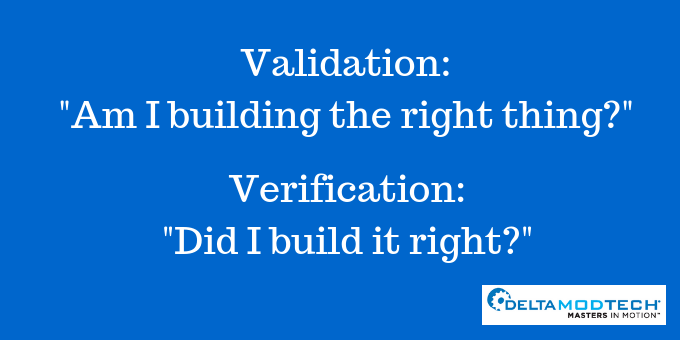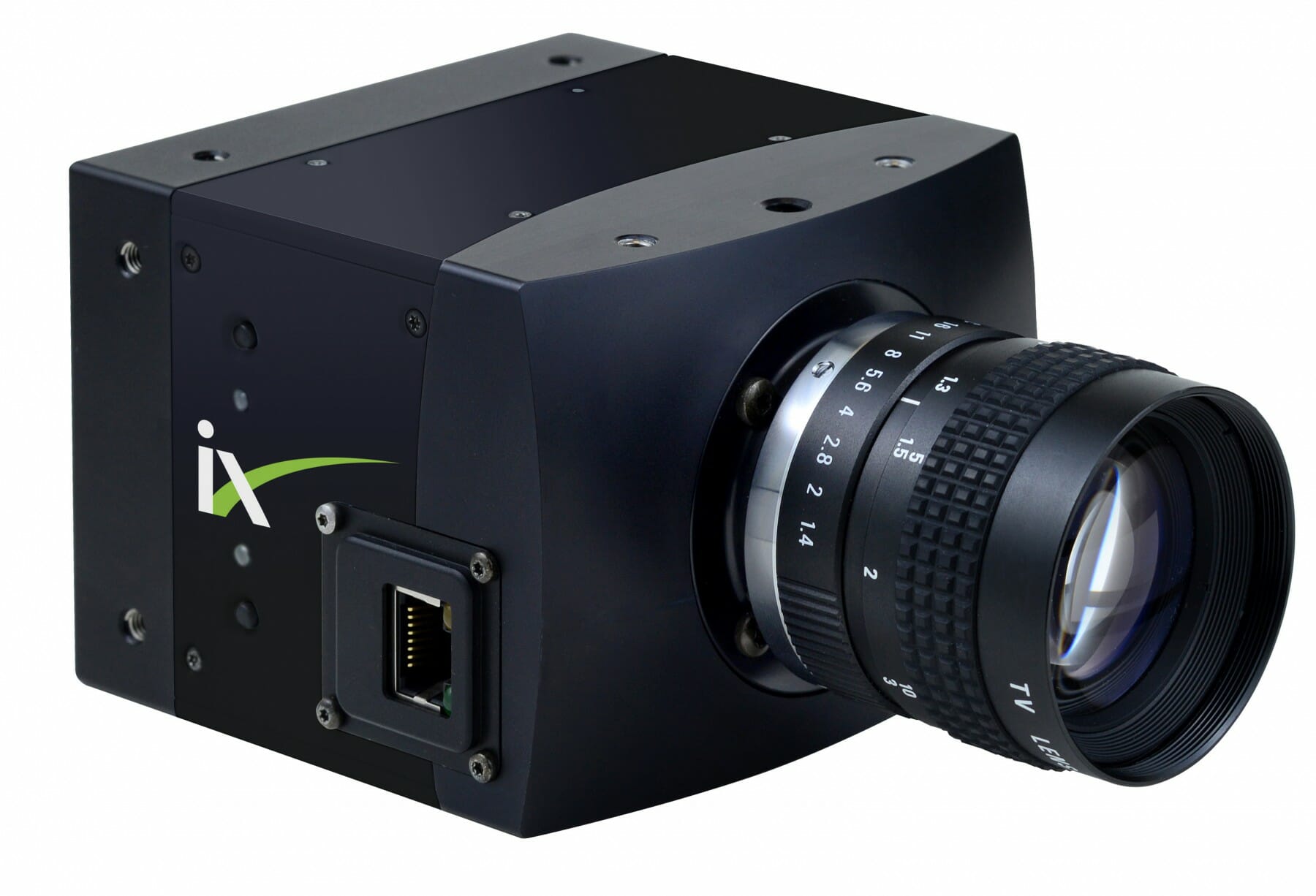
Verification vs. Validation: Using a Transdermal Patch to Explain the Difference
The terms validation and verification are used in many industries. In this post, we are referring to them in the context of the converting industry, including an in-depth look at verification tools and different key elements of validation.
What is Validation vs. verification?
Validation: The assurance that a product, service, or system meets the needs of the customer and other identified stakeholders. It often involves acceptance and suitability with external customers.
Verification: The evaluation of whether or not a product, service, or system complies with a regulation, requirement, specification, or imposed condition. It is often an internal process.
These definitions are according to the PMBOK guide, a standard adopted by IEEE.
In essence, you’re using validation to ensure your product meets the needs of customers (such as end users and brand owners). With verification, you’re ensuring the product meets your specs — that you’ve built what you intended to create and met the guidelines of regulated bodies such as the FDA.
What comes first – verification or validation?

A simplified way to think about the process is “Am I building the right thing?” (validation) vs. “Did I build it right?” (verification).
Yet as we all know in product development, what you build might not always meet the specifications of customers and regulatory bodies. That’s why there are various stages of validation, so you may validate before and after the verification.
For example, you’ll want to ensure that a product meets consumers’ needs at the beginning of the project (prospective validation), then test it to see if what you produced meets the specs (verification), then validate that the actual product truly does meet the consumers’ needs (retrospective validation stage).
Verification vs. Validation Example: A Transdermal Patch Comes to Market
Ok, we’ve provided some conceptual definitions. Let’s take a look at how they apply to the production of a transdermal patch.
Transdermal patch manufacturing usually starts with a need in the marketplace. Whether it’s the introduction of a new drug, or a need for a design that adheres to new FDA guidelines, you’re going to produce a new transdermal patch.

The validation process ensures the specifications of that patch meet your needs — and ultimately the end user’s needs — on multiple levels. This includes:
User requirements: Do the specs address what your product is intended to accomplish?
FDA requirements: Because we’re dealing with a medical device, there are undoubtedly regulatory guidelines to follow. Do the specs adhere to FDA regulatory guidelines?
Your requirements: Do the specs address your cost structure, your capabilities and your production timeline? What transdermal patch materials will you need?
Validation helps us answer these questions.
What you need to validate your product
The following items must be in place, otherwise it will be difficult to proceed with document creation and guarantee compliance.
1. Documented Evidence
You need to produce a deliverable that validates how your manufacturing processes meets specific standards. Your documented evidence can take many forms — a separate document, an FDS, a disaster recovery procedure.
Within that documentation, there are certain protocols you must follow. For example, let’s say the User Requirements Specification or URS requires that the transdermal patch is marked with a UDI (Unique Device Identifier).
In the FDS (Functional Design Specification) for the machine there needs to be a section that describes the method that will be used to create the UDI on the transdermal patch.
Furthermore, there will be a test proving that this requirement has been met. A trace matrix will be used to reference the documented evidence. A trace matrix is a table that ties the URS requirements to their specific locations in the FDS, test procedures, schematics, etc.
Key Items for Validation
- List of relevant regulatory standards
- Drawings defining product tolerance and features
- Product identification: liners, adhesives, active drugs, etc.
- Parameters for critical processes: heat sealing: time/temp/pressure, nip and die pressures, unwind and rewind tensions, etc.
- Chemistry (volumes, components)
- Machine drawings and electrical schematics
- Fabrication methods, including certs if needed
- Surface finish requirements, including certs if needed
- Raw material requirements, including certs if needed
2. Predetermined Specifications
These are the specifications relative to the standards you must maintain. They may be regulatory standards such as FDA, OSHA, CE, guidance such as GAMP, and/or internal company standards such as a quality system or ISO 13485.
Clearly defining these predetermined specs will help you throughout the manufacturing process. For example, with transdermal patches, specs might include:
- Dosage (typically determined by chemistry, coating thickness and patch size)
- Identification (lot/date code and any other applicable UDI requirements)
- Usability (does it stay on once applied — does the pouch seal — is it easy to open)

When we work with clients, we carefully discuss their needs and their predetermined specifications upfront, before we even begin designing a machine.
Key Items for Validation
- Process requirements/outline
- Process timeline
- Process resources
- Change control requirements
- Utility/electrical requirements
- Room layout/spec considerations
- Process layout
3. Product Quality
Arguably, this is the most important element of validation, and it can also be the most difficult. That’s because your success will be defined by the level of detail you produce.
From the materials used in production to the tolerances of the end product, the more specific you are in defining the product quality, the more successful your equipment manufacturer will be.
If you want us to guarantee quality transdermal patches, for example, you need to be specific about what materials you plan on using, and provide us with samples of the materials to test our machines.
Key Items for Validation
- Health and safety requirements
- Control system requirements
- Production rate/materials
- Production rate/tolerances
- Production material data sheets
- Preferred suppliers
- Spare parts requirements
Examples of Verification: The Hardware Used to Measure Those Transdermal Specs
As we move into the verification process, you need to verify that your manufacturing process and the final product meet the specs. In this case, it requires actual measurements of the product – the transdermal patch.
Once the machine is in production, it is possible to do the verification using an integrated vision inspection system. However, the products should first be verified using one of these offline solutions.
Tolerances are extremely important with the production of medical products, and these measurement tools are incredibly precise. Here are a few examples of tools we use to verify specs:
Optical Comparator
Essentially, this is a very flexible microscope that can move around an object. In our example, the transdermal patch sits flat, and the camera moves around it, making measurements and checking tolerance.
The Optical Comparator can be programmed to check various tolerances on a part. This allows you to place several parts from a Factory Acceptance Test on the glass (inspection surface) and quickly do a verification test for product conformity.
Having this available during qualification and acceptance testing allows the end user to quickly make adjustments to the process and immediately check results. The alternative is to check the parts at a lab, which will slow the process.
An In-Depth Look at an Optical Comparator from Mitutoyo Corporation

Optical comparators project a magnified shadow of a workpiece onto a viewing screen so that linear and angular measurements can be made. The workpiece is mounted on a precision measuring stage and moved around in the illuminating beam so that the points of interest are brought to a reference point (crosshairs) at the center of the screen, also the center point of a screen protractor and position readings taken from the stage.

Almost all comparators are capable of illuminating an object for contour only, surface only, or for both at the same time. Modern comparators feature a digital readout for XY linear measurement, and in most cases, for angular measurement as well as to one minute of arc resolution.
Vision Measuring Systems
The integration of optical imaging, computer-aided vision and position-control technology has led to vision measuring systems. A video image of the feature to be measured is captured, magnified and analyzed by the edge-detection system. If all points are not visible in that frame, then the stage is moved to locations where they can be acquired.

While under-stage lighting is used for standard profile work, the surface lighting options can illuminate the workpiece surface from practically any direction, allowing for optimal contrast in the image to bring difficult-to-measure features into focus. On certain types of parts, these systems are unmatched for obtaining non-contact, highly-accurate measurements.

A non-contact system such as vision measuring systems are faster than many contact systems because there is no need for a touch-trigger cycle. They also have a much higher magnification range than optical comparators. Unlike optical comparators, which rely on an operator to make measurements, a vision system is controlled entirely by software.
Peel Tester – Force and Torque Measurement
Many transdermal patches are produced in a pouch — think of a band-aid that has two strips that need to be peeled apart to reveal the adhesive. The peel tester will test the amount of force that is required to peel back the pouch so that the contents are not disturbed.
Force and torque measurement products measure all kinds of things, from syringe activation force to pill crush force to suture strength. Check out Mark-10 products for an example.
Temperature Probes for Heat Sealing
Temperature probes can be used to verify the temperature of the heated component and provide verification of heat set-points and temperature display on the machine’s operator interface.
Handheld temperature probes and IR temperature guns can be used for verification but can be difficult to get consistent readings. Advanced systems can have temperature controllers and thermocouples integrated into heated components strictly for use during validation and verification as detailed in this great post by Packaging Digest.
Decibel Meter
This checks the noise level of a machine when it is in production. Typically, this is determined by corporate policy or an outside body such as OSHA.
Digital Tachometer
This tool is used to verify changes in speed at the servo driven roller and to verify accuracy of the display on the interface.
Checking the Process: Outside of Verification and Validation
There are also tools that help us troubleshoot issues with the machine process itself. This is outside the validation and verification process; it has to do with the process of producing the product.
We’ve featured one of the many tools we use to give you an idea of how precise you need to be with many converting production processes, especially medical and pharmaceutical products.
High-Speed Camera

Transdermal patches require extremely fast converting machines that perform incredibly sophisticated processes. A production issue can occur in a blink of an eye, which is why we use high-speed cameras that shoot over 1,000 frames per second.
An In-Depth Look From iX-Cameras
A high-speed camera uses a custom sensor to enable many frames per second to be recorded, a standard camera would operate at 30 fps (Frames Per Second) but high-speed video cameras can offer frame rates up to around 1,000,000 fps. In order to achieve these high frame rates the camera has very parallel internal memory that is used during record time.
Typical frame rates for manufacturing processes can vary from 500 fps to 5,000 fps. 500 fps would be a labeling or packing process and then up to 5000 fps for a seaming process.
How Does it Work?
This memory is used very quickly, normally only lasting 5 seconds. If the recording was to stop at the end of that memory then it would be very difficult to use, so once at the end of the memory the camera then returns to the beginning of the memory and continues in a loop until stopped. The slow motion video can now be simply viewed or saved off for later review or analysis.
A high-speed video camera can video each process and be used to measure inactive machine time; often this has only been optimized by the human eye and is good to the nearest second. But with a slow motion view of the process, the machine’s timing can be optimized to the nearest millisecond and therefore increase product throughput.
Validation vs. verification testing: Where Does it End?
Both validation and verification processes seem endless. Consider verification: Not only do you have to verify the manufactured part, you also have to verify the machine that makes the manufactured part.
For example, we use a variety of calibration tools — such as temperature probes, digital tachometers, portable web tension transducers — to ensure our machines are maintaining tight tolerances.
We also have to verify that the calibration tools themselves are calibrated effectively. We calibrate the calibration tools.
Manufacturing medical devices require an understanding of both verification and validation
When you’re dealing with the extremely tight tolerances and stringent regulations, validation and verification requires going to great lengths — or in the case of transdermal patches, tiny lengths.
Ultimately, the extra effort will result in a win-win-win transdermal patch: One that works for consumers; provides a proven-quality approach for regulators; and creates a viable, long-term product for manufacturers.
OVERCOME YOUR BIGGEST CONVERTING AND PACKAGING CHALLENGES
Published on Nov 12 2018
Categories: Delta ModTech Blog, Validation


